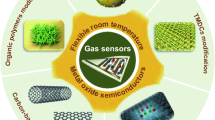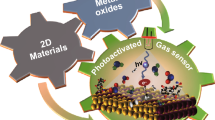Abstract
In this report, a systematic study is carried out to check the superiority of the oxidation techniques employed for improving the surface stability of Porous Silicon (PS). PS samples were oxidized in three different atmospheres viz. ambient air, oxygen gas and the mixture of oxygen and nitrogen gas. Among them, samples oxidized under O2 atmosphere proves to be the best yielding excellent stable surface and no degradation observed even after one year. The qualitative analysis of the surface morphology, surface bond termination, and degradation, if any, of the oxidized PS samples were done by scanning electron microscope, micro-Raman, Photoluminescence and Fourier Transform Infrared spectroscopy. Electrical capacitive technique is used to check the ageing effect of the sensor device made from thermally oxidized PS. Ethanol vapor sensing was periodically made in the range of 25–100 ppm for one year, and any noticeable degradation is not observed in its sensing performance.







Similar content being viewed by others
References
L.T. Canham, Silicon quantum wire array fabrication by electrochemical and chemical dissolution of wafers. Appl. Phys. Lett. 57, 1046–1048 (1990)
O. Bisi, S. Ossicini, L. Pavesi, Porous silicon: a quantum sponge structure for silicon based optoelectronics. Surf. Sci. Rep. 38, 1–126 (2000)
K. Kordas, S. Beke, A.E. Pap, A. Uusimaki, and S. Leppavuori, Optical properties of porous silicon. Part II: fabrication and investigation of multilayer structures. Opt. Mater. (Amsterdam, Neth.) 25, 257–260 (2004)
G. Lammel, S. Schweizer, P. Renaud, Microspectrometer based on a tunable optical filter of porous silicon. Sens. Actuators, A 92, 52–57 (2001)
T. Holec, T. Chvojka, I. Jelínek, J. Jindrich, I. Nemec, I. Pelant, J. Valenta, J. Dian, Determination of sensoric parameters of porous silicon in sensing of organic vapors. Mater. Sci. Eng., C 19, 251–254 (2002)
A. Foucaran, F. Pascal-Dellamnoy, A. Giani, A. Sackda, P. Combette, A. Boyer, Porous silicon layers used for gas sensor applications. Thin Solid Films 297, 317–320 (1997)
S. Zairi, C. Martelet, N. Jaffrezic-Renault, R. M’Gaieth, H. Maaref, R. Lamartine, Porous silicon a transducer material for a high-sensitive (bio)chemical sensor: effect of a porosity, pores morphologies and a large surface area on a sensitivity. Thin Solid Films 383, 325–327 (2001)
H. Luth, M. Thust, A. Steffen, P. Kordos, M.J. Schoning, Biochemical sensors with structured and porous silicon capacitors. Mater. Sci. Eng., B 104, 69–70 (2000)
T.M. Benson, H.F. Arrand, P. Sewell, D. Niemeyer, A. Loni, R.J. Bozeat, M. Kruger, R. Arens-Fischer, M. Thonissen, H. Luth, Progress towards achieving integrated circuit functionality using porous silicon optoelectronic components. Mater. Sci. Eng., B 69–70, 92–99 (1999)
R.J. Martin-Palma, J.M. Martinez-Duart, L. Li, R.A. Levy, Electrical behavior of double-sided metal/porous silicon structures for optoelectronic devices. Mater. Sci. Eng., C 19, 359–362 (2002)
K.D. Hirschman, L. Tsybeskov, S.P. Duttagupta, P.M. Fauchet, Silicon-based visible light-emitting devices integrated into microelectronic circuits. Nature 384, 338–341 (1996)
Saakshi Dhanekar, S.S. Islam, T. Islam, Harsh, Highly sensitive porous silicon sensor: detection of organic vapours using photoluminescence quenching technique. Int. J Smart Sens. Intell. Syst. 3, 1–13 (2010)
M. Bjorkqvist, J. Salonen, E. Laine, L. Niinistö, Comparison of stabilizing treatments on porous silicon for sensor applications. Phys. Stat. Sol. (a) 197, 374–377 (2003)
D.B. Mawhinney, J.A. Glass Jr, J.T. Yates Jr, FTIR study of the oxidation of porous silicon. J. Phys. Chem. B 101, 1202–1206 (1997)
J. Salonen, M. Bjorkqvist, E. Laine, L. Niinisto, Stabilization of porous silicon surface by thermal decomposition of acetylene. Appl. Surf. Sci. 225, 389–394 (2004)
S.T. Lakshmikumar, P.K. Singh, Stabilization of porous silicon surface by low temperature photo assisted reaction with acetylene. Current Appl. Phys. 3, 185–189 (2003)
R. Boukherroub, D.D.M. Wayner, G.I. Sproule, D.J. Lockwood, L.T. Canham, Stability enhancement of partially-oxidized porous silicon nanostructures modified with ethyl undecylenate. Nano Lett. 1, 713–717 (2001)
A. Nakajima, T. Itakura, S. Watanabe, N. Nakayama, Photoluminescence of porous Si, oxidized then deoxidized chemically. Appl. Phys. Lett. 61, 46–48 (1992)
J.C. Vial, A. Bsiesy, F. Gaspard, R. Herino, M. Ligeon, F. Muller, R. Romestain, Mechanisms of visible-light emission from electro-oxidized porous silicon. Phys. Rev. B 45, 14171–14176 (1992)
V. PetrovaKoch, T. Muschik, A. Kux, B.K. Meyer, F. Koch, Rapid thermal oxidized porous Si-The superior photoluminescent Si. Appl. Phys. Lett. 61, 943–945 (1992)
H. Saha, Porous silicon sensors- elusive and erudite. Int. J. Smart Sens. Intel. Syst. 1, 34–56 (2008)
J.M. Buriak, M.J. Allen, Lewis acid mediated functionalization of porous silicon with substituted alkenes and alkynes. J. Am. Chem. Soc. 120, 1339–1340 (1998)
A.E. Pap, K. Kordas, G. Toth, J. Levoska, A. Uusimaki, J. Vahakangas, S. Leppavuori, Thermal oxidation of porous silicon: study on structure. Appl. Phys. Lett. 86, 041501 (2005)
Saakshi Dhanekar, S.S. Islam and Harsh, Photo-induced electrochemical anodization of p-type silicon: achievement and demonstration of long term surface stability. Nanotechnology 23, 235501, (8 pp) (2012)
P. Gupta, A.C. Dillon, A.S. Bracker, S.M. George, FTIR studies of H20 and D2O decomposition on porous silicon. Surf. Sci. 245, 360–372 (1991)
Z.H. Xiong, L.S. Liao, S. Yuan, Z.R. Yang, X.M. Ding, X.Y. Hou, Effects of O, H and N passivation on photoluminescence from porous silicon. Thin Solid Films 388, 271–276 (2001)
M.A. Vasquez-A., G.A. Guila Rodrıguez, G. Garcıa-Salgado, G. Romero-Paredes, and R. Pena-Sierra, FTIR and photoluminescence studies of porous silicon layers oxidized in controlled water vapor conditions. Revista Mexicana De Fisica 53, 431–435 (2007)
A. Bragaru, M. Simion, M. Miu, T. Ignat, I. Kleps, V. Schiopu, A. Avram and F.C.R. Aciunoiu, Study of the nanostructurated silicon chemical functionalization. Romanian J. Inf. Sci. Technol. 11, 397–407 (2008)
J. Salonen, V.-P. Lehto, E. Laine, The room temperature oxidation of porous silicon. Appl. Surf. Sci. 120, 191–198 (1997)
W.J. Salcedo, F.J. Ramirez Fernandez and E. Galeazzo, Structural characterization of photoluminescent porous silicon with FTIR spectroscopy. Brazilian J. Phys. 27, 158–161 (1997)
M.A. Hory, R. Hkrino, M. Ligeon, F. Muller, F. Gaspard, I. Mihalcescu, J.C. Vial, Fourier transform IR monitoring of porous silicon passivation during post-treatments such as anodic oxidation and contact with organic solvents. Thin Solid Films 255, 200–203 (1995)
Nanotechnology Enanbled Sensor by Kourosh Kalantar-zadeh & Benjamin Fry, Springer, ISBN 978-0-387-32473-9
Y. Kanemitsu, Photoluminescence spectrum and dynamics in oxidized silicon nanocrystals: a nanoscopic disorder system. Phys. Rev. B 53, 13515–13520 (1996)
Acknowledgments
The authors gratefully acknowledge the financial support provided by Department of Science and Technology, Govt. of India, through its Grant No. SR/S2/CMP-0053/2009 to carry out this work.
Author information
Authors and Affiliations
Corresponding author
Rights and permissions
About this article
Cite this article
Aggarwal, G., Mishra, P., Joshi, B. et al. Porous silicon surface stability: a comparative study of thermal oxidation techniques. J Porous Mater 21, 23–29 (2014). https://doi.org/10.1007/s10934-013-9742-y
Published:
Issue Date:
DOI: https://doi.org/10.1007/s10934-013-9742-y




